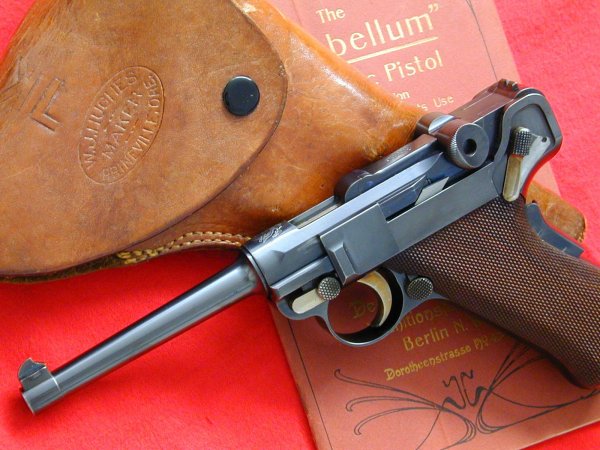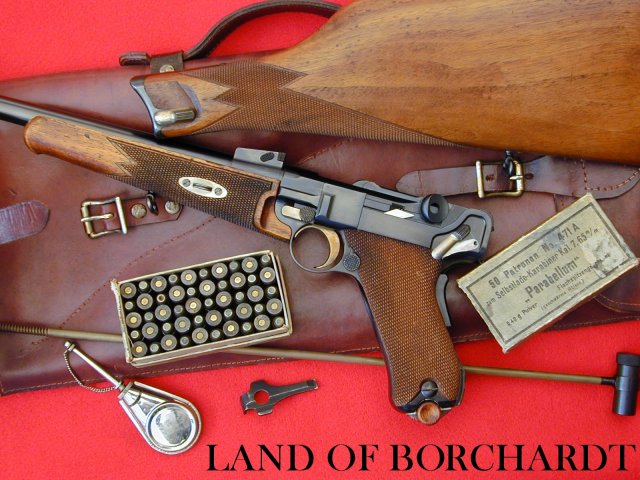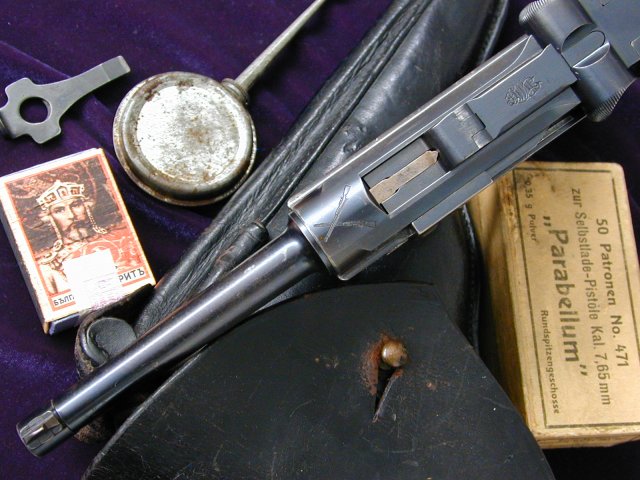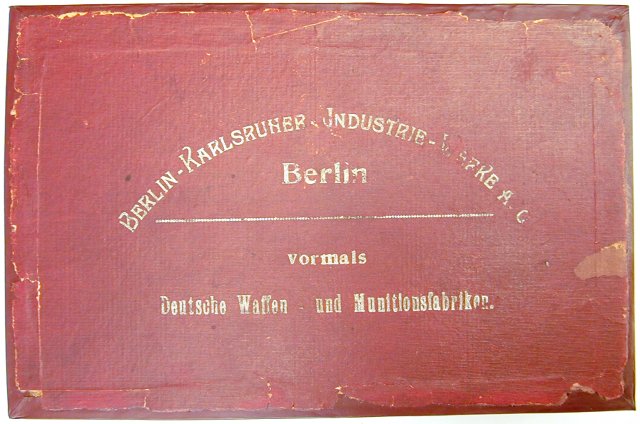Other Lugers
- 1900 Russian Luger
- Early production 1900 American Eagle Luger, Classic Americana old model holster and 1902 English language instruction manual.
- Cased 1900 early production Commercial Luger and accessories.
- 1902 Luger Carbine rig showing carbine ammo.
- 1902 7.65mm Danzig army test Luger.
- 1920s BKIW box with a 1920s 4 digit i suffix SN commercial 30 cal Luger.
1900 Russian Luger with accessories
|
 |
M1900 Russian Parabellum article |  | ||||||||||||||||||||||||||||||||||||||||||||||||||||||||||||||||
|
The only literature or documentation that can be found on the Model 1900 Russian Parabellum is in two books, J. Walters THE LUGER BOOK on page 239, paragraph R67 RUSSIA and in C. Kenyon's book Luger: The Multi-National Pistol on page 110. The subject in both books is mainly the 1906 Russian 'Contract' Luger, of which its existence has been established, with only a reference to earlier Russian tests with the M1900. In Walters book it's only an indirect reference stating: "There is no doubt that Parabellums were tested at the Oranienbaum proving ground in 1904, because some of the results are noted by Fedorov. The German pistol was known in Russia as the 'Avtomaticheskii Pistolet BorkhardtaLyugera' and the gun tested in 1904 was a 7.65mm 12cm-barreled 1900 model." Note:
By the time of the M1906, the Luger had reached a much higher visibility and acceptability level in the eyes of the world and the military. No doubt more of the improved 'New Model' 1902/06 Parabellums were distributed to Russian Ordnance personnel and officers for field tests in about 1908 than was originally tested of the 'Old Model' 1900 in the 1902/04 time frame. This can be attested to by their unique serialization that places them in the category of a recognized 'contract' series. There are some Luger historians that say that there were no military tests, at least regarding the 1902/06 and that the 1902/06 Russian Parabellum contract was for the local police or 'gerndarmes.' Walter states that "The destination of the 'Russian' New Model Parabellums remains a mystery. Their crossed-rifles chamber mark suggest military rather than police use, perhaps the Okhrana -- the secret police -- or the Tsar's bodyguard." The Luger Pistol by Fred Datig, published in 1958 and Luger Variations by Harry Jones, published in 1959 both feature a 1902/06 Russian Parabellum. The M1902/06 Russian being found by collectors at least as early as 1958 vs. 1987 for the first discovery of the M1900 Russian Luger can only be explained by the fact that there were very few M1900 Russian Lugers. There is no apparent reason that it would be any harder to locate an M1900 7.65mm Russian vs. an M1902/06 9mm Russian. There is no way of knowing whether the tested 1900 model Luger(s) were actually marked with the Mosin-Nagant '91 crossed rifles on the chamber and the Cyrillic marking for 'FIRE' stamped in the Thumb Safety area, or whether it was just an unmarked 1900 commercial, although "the late" Harry Jones once advertised a 1900 Russian, serial number 12474 for sale with the Mosin-Nagant '91 crossed rifles on the chamber, with the thumb safety area curiously 'blued’, and with documentation claiming it to be a Russian test gun "TEST ORANIENBAUM" 1904. Per J. Walters in THE LUGER BOOK, at least one M1900 was tested at the Oranienbaum proving ground in 1904. However, there is no evidence stating the gun tested had the Mosin-Nagant '91 crossed rifles on the chamber. A GUNS&AMMO July 1989 article written about the Old Model Lugers titled The Lure and Lore of the Luger states on p.89 "...and until recently, it was believed that Bulgaria was the only other country to receive a special die. However today’s Luger fact is tomorrow’s misnomer. In the past few years, examples of Russian contract Model 1900s bearing the crossed Mosin-Nagant rifles associated with the M1906 Russian have surfaced, joining the plain chambered commercial as another recognized variation." The identified M1900 Russian Lugers to date do not have Cyrillic markings in the Thumb Safety area. The M1900 Bulgarian still has the distinction of being the first M1900 to have the upper safety lever area of the frame marked Bulgarian for 'FIRE’. A well known dealer/collector, who owns an M1900 Russian Luger, acknowledges the existence of the M1900 Russian Luger by including it in his periodic price list with the following description: "Very few ever made, until 1987 never seen, but known, extremely rare." The M1900 7.65 mm Russian is not listed in Fjestad's Blue Book of Gun Values. I have identified eight (8) M1900 7.65 Russians to date. The serial numbers are in the range of 11356 to 12918 and are 11356, 12052, 12059, 12324, 12474, 12662, 12821, 12918. The conditions of these guns range to 95% original condition to hot dip blued to very poor condition 9mm rebarrels. There are at least (9) nine M1902/06 9mm Russians identified. They are 193, 313, 319, 345, 560, 747, 868, 869, 876. I have been documenting Old Model Luger serial numbers for several years and except for the eight M1900 Russian Lugers, there is a big gap in the serial number range starting from about 11000 to 13000. The gap starts above 10854 and ends at 13470. The gap could be different, depending on other Luger collectors' observations. Per Kenyon in Luger: The Multi-National Pistol on page 68, "Mexican" Lugers were tested and a small quantity in the serial number range of 12800-13000 were issued to Mexican Artillery and Cavalry units. (There are three known examples.) These Lugers were culled from M1900 commercial production and marked "EJERCITIO MEXICANO" on the left side panel. Identifying serial number 12918, an M1900 Russian, that falls in the "Mexican" range, is another example of the random nature of non-consecutive distribution by DWM. This still leaves a missing serial number block in excess of 2600 and is too big, assuming even a maximum of 1000 non-consecutive serialized M1900 Russians and a couple hundred "Mexican" Lugers. What and where are these missing Lugers? In conclusion, there will undoubtedly be other M1900 Russian Parabellums 'found' but probably not many because of the above huge gap in the 11000 to 13000 serial number range. Obviously a gap that large could include M1900 commercials, Swiss commercials, American Eagles, 'Mexican' Lugers, and possibly other unknown variations. Except for the 'Mexican' Luger and the M1900 Russian Luger, no other variation has been found in this serial number range. As of this writing there are two well-known Luger collectors and authors who recognize the existence of the M1900 Russian, enough to include them in their collections. ”Two 1900 Russian 4-¾" Lugers are known to exist, one in London and one in the author's Collection.” (excert from the book, Lugers, published by David B. Mauser, P. 20) The M1900 Russian is highly valued. However, the 1906 Russian 4" Luger is valued even more because it is rocognized as a contract Luger. Obviously any M1900 Russian Luger identified should be examined by experts for authenticity. There are other noted Luger collector/dealers that are extremely reluctant to accept the M1900 Russian Parabellum as reality, although, given the chance of possession they would, without hesitation, advertise for a high sum. The fact that eight M1900 Russian Parabellums have been identified is irrefutable testimony to its existence, and when the next noted Luger author picks up the pen for the next chapter in Luger history, hopefully, will acknowledge and recognize the Model 1900 Russian Parabellum as a legitimate and unquestionable LUGER VARIATION. Additional theories in support of the M1900 Russian Luger variationSerial number dispersalAfter compiling the list shown in Table 1, of the serial numbers of observed Model 1900 and 1900/02 Parabellums, excluding the Model 1900 Swiss Ordnance variation, the following conclusions were made:
It seems certain from looking at the table that the 1900 Russian Parabellum is a genuine Luger variation. If there were American Eagles, Commercials, or Swiss Commercials in the same serial number block as the Russian, surly some of them would have surfaced. The argument that a block of serial numbers was either lost or destroyed has no validity -- only if that block was exclusively Model 1900 Russians, and that is highly unlikely if one looks at the blocks of serial numbers on either side of the Russians, one can see a similar dispersal rate. In other words, the 1900 Russian is encountered at about the same amount or ratio as the American Eagle! The 1900 Russian variation is rare mostly because there were few made, much less than the highly rare 1900 Bulgarian variation. The discovery rate of the 1900 Russian is therefore really not much different than the 1900 American Eagle, which is interesting since the 1900 Russian was sold to a closed society vs. the exclusive U.S. export of the American Eagle. The fact that the 1900 Russian Luger was never observed until the 1980s has no bearing on its legitimacy or rarity, and in actuality the 1900 Russian Luger variation has been known to exist since the 1950s.
Mosin-Nagant '91 crossed rifles crest
The original rifle did not have a wooden 'hand guard' on the top of the rifle barrel, the swivel loops were located on the forward end of the magazine body and on forward forestock clamp (there were no sling swivels located in the wooden stock or forestock). Also on the original 1891 there was a 'finger rest' located on the wooden stock to the rear of the trigger guard.
The 1893/94 variation of the 1891 was changed as follows: The barrel proved to be loose (or not stable when fired) in the wooden forestock cradle so a wooden upper forestock was added to the top of the barrel. The other change was to remove the 'finger rest.' This was done to balance the costs of adding the upper wooden 'hand guard.' This is the extent of the modification.
The original 1891 Mosin-Nagant rifle used round nosed bullets which brings us to the last modification that occurred in 1908, and that change was to accommodate a pointed bullet. Three changes were made, the first change was to modify the rear sight ramp to correct for the different ballistic characteristics of the new pointed bullet. The original sight ramp had jagged edges or steps machined into a linear ramp with a flat sight leaf whereas the modified ramp had jagged edges or steps machined into a curved surface using a curved sight leaf. The second change was to remove the band and magazine-mounted sling swivels. The sling swivels were replaced and slots were added, one in the stock and one centered in the lower forestock, to accommodate a leather sling. The Finish added the metal loops. The third change, a bolt was installed laterally through the gun frame and stock in the rear of the wooden recess finger slot for stability required due to increased chamber pressure. The distance created between the chamber surface by adding the upper wooden forestock in 1893/94 is less than ¼ inch and is the same on the later revised 1908 model. This dimension cannot be practically used to define any difference between the 1900 Russian Parabellum rifle crest vs. the 1902/06 Russian Parabellum rifle crest as both crests are identical. The only differences between the original 1891 Mosin and the revised rifle (1893/94) that the DWM German designer or die maker might have paid attention to is the removal of the band and magazine-mounted sling swivels and placing slots in the stock and lower forestock and the addition of the bolt (1908), and since neither the 1900 nor 1902/06 Russian Parabellum crests show swivel loops, the added slots nor the added bolt, the discussion of the changes is academic. With the Russian crest being less detailed and more of a silhouette, than the Bulgarian crest and the American Eagle crest, adding sling swivels (or slots) to a crest design with a rifle length of less than 0.60 inches (17mm) by a maximum width of 0.060 inches (2mm) at the rifle butt would not be realistic. Both the 1900 and 1902/06 Russian crests look alike because they represent the same model TYPE. Since neither the 1900 or the 1902/06 crests look like the original 1891 rifle, the difference between the original 1891 Mosin-Nagant rifle and the modified (1893/94, 1908) models is mute. Both crests represent the 1893/94 or later variation of the Model 1891 Mosin-Nagant rifle TYPE only. The strongest published comments attesting to the legitimacy and authenticity of the M1902/06 Russian Parabellum variation states that the crossed rifles on the chamber are of the 1891 Mosin-Nagant TYPE only. No specific variation of the 1891 is implied. When examining the M1900 and the M1902/06 Russian Parabellum Mosin-Nagant rifle crests in great detail, the following observations are noted.
With the above in mind, the Russian Mosin-Nagant rifles in saltire crest found on the M1900 and M1902/06 Russian Parabellum is a die makers' concept of the Mosin-Nagant rifle only, and was not meant to duplicate exactly the 1891 Mosin-Nagant rifle and specifically the fact that the M1900 and M1902/06 crests are identical cannot be used alone to deny the existence of the 1900 variation, since the Mosin-Nagant rifle TYPE shown on both crests existed as early as 1893/94. Another basis for the rejection of the M1900 Russian Parebellum variation will have to be found.
Other theories Another theory advanced is that the M1900 Russian Parabellum was never in Russia. Possibly a few hundred were ordered from DWM by a Russian gun merchant, with a special request for a crossed rifle insignia to be applied on the chamber, who canceled the order after the crests were applied, and the guns so stamped were sold locally [in Germany], or elsewhere. E. Bender's book Luger Holsters & Accessories features a 1906 published catalog of the firm E.E. Chukov in St. Petersburg (less than 30 miles from the Oranienbaum proving grounds). Page 57 of this catalog shows an M1900, 7.65 mm Parabellum and a M1902 Carbine. The front page of the E.E. Chukov catalog has a crossed rifle logo. Sources:
| ||||||||||||||||||||||||||||||||||||||||||||||||||||||||||||||||||
Early production 1900 American Eagle Luger, Classic Americana old model holster and 1902 English language instruction manual.
 |
Cased 1900 early production Commercial Luger and accessories.
 |
1902 Luger Carbine rig showing carbine ammo.
 |
1902 7.65mm Danzig army test Luger.
 |
 Home page
Home page


